Dairy farm confined spaces
Confined spaces on dairy farms can be dangerous. Employers and workers must understand the hazards and know how to work with them before entering the confined space.
The hazards
Below, you'll find general information to help you assess the hazards of confined spaces on dairy farms. Please note: there may be confined spaces on your farm not listed here.
Augers and conveyors transport solid material either from a container to a vehicle or from one location to another. The enclosure containing the auger or conveyor is a confined space.
Depending on the material being transported, toxic gases may build up in the conveyor system. Fermenting material, such as compost, may emit toxic gases that can rapidly cause death when inhaled at high concentrations. Grain and feed can emit fumigants and dust.
To help reduce the risk, choose (or retrofit) equipment so workers don't have to enter the conveyor system to perform maintenance or repairs.
| Hazards | Hazardous work |
|
|
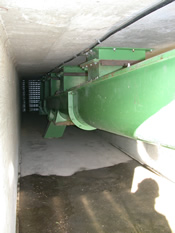
Conveyor in a tunnel
When damp materials (such as forage plants, compost, or damp feed) are stored in a bunker they can ferment and produce hazardous gases. Oxygen is consumed in the fermentation process. Other hazardous gases may be produced from vehicles, such as front-end loaders, as they enter and leave the bunker. The gases may accumulate at the surface of the material and collect at the base of the bunker — especially if the bunker is below ground level.
Above-ground, open-front bunkers are not normally considered confined spaces as long as access is relatively easy for workers and equipment. However, if bunker contents block the entrance they may create a confined space. Pit or subsurface bunkers are also considered confined spaces.
| Hazards | Hazardous work |
|
|
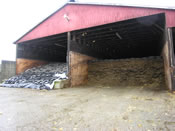
Above-ground bunker
If there is not enough ventilation, crawl spaces or cellars may contain a toxic or low-oxygen atmosphere. The combination of metal and moisture can deplete oxygen because oxygen is used as metal rusts. Other toxic gases may also accumulate, depending on the use of the building above the crawl space or material being stored in the crawl space.
| Hazards | Hazardous work |
|
|
 |
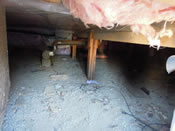 |
Exterior entrance and crawl space
Normally, grain or feed storage bins do not produce toxic gases. However, you must consider any previous use of pesticides or fumigants, and possibly mould. If the grain's moisture content is too high, the grain may ferment. Toxic gases can then build up, replacing oxygen in the air.
To help reduce the risk, design the cone of a hopper-bottomed bin using bolted joints (rather than welded joints) so you can remove individual panels. Auger cleaning and maintenance can then be done safely from outside the hopper.
| Hazards | Hazardous work |
|
|

Feed bins
Different dairy farms may have different manure-handling structures. Some might be confined spaces.
Manure can be collected to a subfloor or outside storage chamber using mechanical floor sweepers or mobile equipment. As bedding material separates, it creates a watery product suitable for long-term storage in above- or below-ground structures.
The manure ferments in these structures, creating very toxic gases. The slightest agitation or movement of the liquid or sludge can release gas bubbles into the air. In high enough concentrations, these gases can cause death in seconds. The toxic gases can accumulate at the top or bottom of ponds, trenches, or sumps that contain manure.
Ammonia and methane are lighter than air and accumulate at the top. Hydrogen sulfide is heavier and tends to sink. As gases build up in the confined space, they may replace oxygen in the air. Some gases, such as methane, are also extremely flammable and can be an explosion hazard.
In these types of confined spaces, another hazard is that workers may accidentally fall into the pits (or through a crust on the surface), becoming engulfed (or surrounded), and drowning.
To help reduce the risk choose equipment that does not require entry for repair or maintenance, such as a removable agitator. To prevent unauthorized entry, install fences around pits.
| Hazards | Hazardous work |
|
|
 |
 |
 |
 |
| Manure pond | Above-ground manure tank | Manure separator | Subfloor manure storage |
On dairy farms, milk tanks are usually horizontal, stainless steel cylinders with small entry hatches on top (near one end of the tank). Milk tanks are double-walled. The space between the walls contains refrigeration piping and insulation.
Normally, hazardous gases won't be present in a milk tank. However, some common cleaning and disinfecting chemicals can produce very toxic gases, even in small amounts. For anyone entering the tank, the greatest risk is from mechanical equipment inside, such as an agitator, that has not been properly de-energized and locked out.
To help reduce the risk, install an automated washer system so workers do not have to enter the tanks.
| Hazards | Hazardous work |
|
|
 |
 |
| Milk tank | Tanker truck |
Mobile equipment used on dairy farms may include:
- Tank wagons (e.g., for pesticides, fertilizers, and liquid manure)
- Mixers (e.g., for mixing feed)
- Spreaders (e.g., for fertilizers)
Tanks may contain toxic gases from fermenting material, such as liquid manure and aerosols from pesticides. Some of these gases and vapours are toxic and can quickly cause death when inhaled at high concentrations. Some cleaning chemicals can also produce very toxic gases, even in small amounts. Low-oxygen conditions may occur if the tank has been empty for some time.
The power take-off of the tractor powers mechanical equipment on the unit. The hydraulic system of the tractor powers the unit's hydraulic system. It is possible for energy to remain in circuits after the tractor has been shut down and linkages and hoses have been disconnected.
To help reduce the risk, choose (or retrofit) equipment that doesn't require entering mixers or spreaders to perform repairs or maintenance.
| Hazards | Hazardous work |
|
|
 |
 |
 |
 |
| Tank wagon | Feed mixer | Mechanical equipment in a feed mixer |
Mobile spreader |
A pump station (also known as a lift station) is a below-ground chamber that collects drainage from surface and subsurface sources. Pumps move the liquid to a higher level such as an above-ground storage tank, drainage structure, or sewer.
Pump stations on dairy farms handle raw liquid manure and liquid manure removed from bedding material. They may also handle relatively clean water collected from roofs and other sources.
As it agitates the sludge, the pump can release trapped toxic gases. Agitation thins the fluid, causing bubbles and foam which release gas into the air. High concentrations of these gases can cause death in a few seconds.
To help reduce the risk, choose (or retrofit) equipment that does not require entering the station to perform maintenance and repairs.
| Hazards | Hazardous work |
|
|
 |
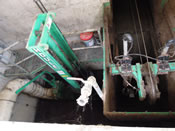 |
| Liquid manure pump station | Liquid manure pump chamber |
When forage plants are stored in a silo they ferment, producing hazardous gases. The fermentation process begins as soon as the plants are stored. It can continue for several weeks. Oxygen is consumed by the fermentation process.
Gases may accumulate at the surface of the silage or forage. They may also flow down, through the silo chute, and collect at the base of the silo (in the loading room). They may even flow into the barn if there is no airtight door.
| Hazards | Hazardous work |
|
|
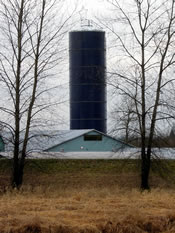
Silo
Sumps are below-ground chambers that collect drainage from surface and subsurface sources. When the trap in the outflow pipe overflows, collected water is then transferred to another location through the outflow pipe. Sumps act as separation chambers before discharging to stormwater drainage.
On dairy farms, sumps can accumulate organic matter in runoff from various sources. Sludge can trap gases from anaerobic digestion. Agitation thins the sludge and releases these gases. Fermentation gases are toxic. When inhaled at high concentrations, they can quickly cause death.
| Hazards | Hazardous work |
|
|
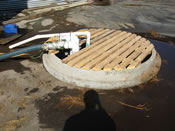
Drainage sump
Valve boxes and valve chambers are small in-ground structures that house one or more valves in a piping system. Valve boxes may barely meet the requirements for classification as confined spaces.
However, people have died while working in these small chambers. The main cause of death is an oxygen-deficient atmosphere. Wastewater containing organic matter may remain in valve boxes long enough to ferment. Fermented liquids may leak from pumps, valves, or pipes, or seep from the surface. Fermentation gases are toxic. When inhaled at high concentrations, they can quickly cause death.
To help reduce the risk, choose (or retrofit) equipment so it does not requiring entering the valve box to perform maintenance or repairs. For example, use pump, valve, or motor-lifting devices.
| Hazards | Hazardous work |
|
|

Below-ground valve box
Dairy farms have water tanks or cisterns for storing water, used to wash down the milk parlour. (A cistern is a waterproof structure used for storing rainwater in dry areas.) These usually include horizontal and vertical tanks made of plastic and steel with hatches at the top. Some farms use open-topped tanks and poured-concrete enclosed cisterns.
Normally, hazardous gases will not be present in a water tank or cistern, as long as the water is clean. However, some cleaning and disinfecting chemicals can produce very toxic gases, even in small amounts. Low-oxygen conditions may also occur if the tank has been sitting empty for a while. For workers, the greatest risk is from drowning, which can occur in as little as 15 cm of water.
Organic matter that has settled to the bottom of an open outdoor tank may ferment and produce highly toxic gases. These gases can quickly cause death when inhaled at high concentrations. These gases may be released if workers are disturbing sediment at the bottom of the cistern (such as walking on the sediment when the cistern is empty).
| Hazards | Hazardous work |
|
|
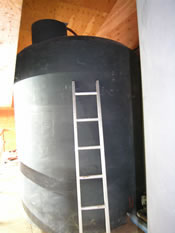
Water tank
A well pit is the chamber at the top of a wellhead. If the chamber is located under the floor of a building it is considered a confined space. The well pit provides access to the well and pumping equipment. It also prevents freeze-up in the pressure tank and piping.
Normally, hazardous gases will not be present in a well, as long as there is very little (or no) organic material in the water. However, oxygen depletion can occur when metal rusts. This is most likely when the well pit is closed for a long time, as condensation forms on metal surfaces.
| Hazards | Hazardous work |
|
|
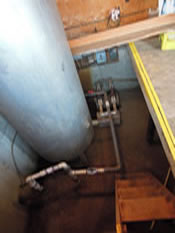 |
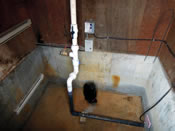 |
| Well pits |
Highlights
- New risk advisory on the dangers of fire and explosion in asphalt mix plants Published on: August 15, 2023
- New online tool helps workers and employers manage risk by delivering a custom list of health and safety resources Published on: December 05, 2022
- New slide show highlights the importance of protecting workers from the hazards of confined spaces in agriculture Published on: August 29, 2022


